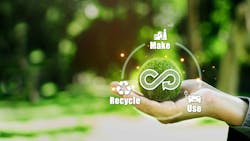Water circularity as a green recovery facilitator
According to the United Nations, global water use has grown sixfold in the last 100 years, growing at a rate of 1% per year, due to economic development, population growth, and consumption patterns. Climate change also affects water availability, but ironically, water production contributes significantly to carbon emissions.
Needless to say, the water and wastewater sector plays a crucial role in addressing the growing water demands and is instrumental to the success of the global 2050 net zero journey. This is where circular economy principles become vital to achieving a sustainable water supply.
The concept of a circular economy is about closing the loops of the linear economy to optimize resources. The emergence of new water technology has brought about a new age where the performance of water services must be seen through the lens of sustainability and efficiency. These objectives can be understood through the paradigm of circularity, where Reduce, Reuse and Recycle become fundamental pillars of sustainable and efficient production.
Tightening the tap on energy efficiency
Whenever energy is used inefficiently, it adds to financial and environmental costs. As highlighted in The World Bank’s 2021 report, “Water in Circular Economy and Resilience” (WICER) the role of the water sector in reducing greenhouse gas emissions includes, among other key actions, the need for energy efficiency measures and self-generation of renewable energy. Energy is often the costliest component of water supply and sanitation operations, ranging from 33% to 82% of non-labor operating costs. However, it is also one of the expenditures that can be most easily addressed through innovative efficiency measures, not least by introducing digital solutions that can optimize, manage and conserve energy.
Water companies increasingly turn to remote monitoring and real-time data analysis to aid energy optimization and reduce consumption. Through enhanced analytics, powered by IoT sensors and the cloud, water companies can collect and read vast amounts of data in real-time. Such advanced data analytics and power monitoring systems can deliver energy savings of up to 8%.
The WICER report is clear that digitization underpins efficiency and sustainability in the water industry.
“Digital solutions offer new ways to optimize, manage, and conserve water,” the report stated. “Digital solutions also help extend and improve the quality of water resources, expand infrastructure life cycles, optimize operations and maintenance, increase energy efficiency, reduce NRW, and help prepare for a changing environment or potential crisis.”
Reducing energy consumption across the water cycle is essential. Whether tackling inefficient pumping systems or ensuring preventative maintenance, all efficiency measures require data to feed insight that spurs action.
A plentiful source of renewable energy
Achieving a green future for water through circularity goes further than increasing energy efficiency. Circularity means maximizing opportunities for the industry to become a contributor to renewable energy, powering itself through alternative energy sources generated within the hydrological cycle.
Water supply and sanitation utilities are increasingly exploring ways to become energy producers. With the right planning and investments, these utilities can achieve energy neutrality or even generate a surplus of energy to sell to the grid. This can look like microgrids at desalination or water treatment plants; wastewater treatment plants utilizing biogas or thermal energy via heat pumps; or microturbines deployed in the water system to capture kinetic energy.
Extending the benefits above and beyond
Circularity is also about seeking ways to harness waste products created in the industrial process so that they become an asset rather than a damaging liability. Globally, most water treatment sludge is discharged to water bodies, sewers, or landfills, which can create damage to ecosystems.
However, adopting a “zero-waste” strategy means materials that may otherwise end up in landfill can be recovered from the sludge treatment and used in other industries such as construction or agriculture. Salt can be extracted from the brine at desalination plants and then used in other industries, such as the resource-heavy textile industry.
Such an approach is not without challenges but is vital to ensure that true efficiency and sustainability is achieved through the water cycle. Reducing energy use is imperative, but if other opportunities to engage in circularity are ignored, there is a risk of giving with one hand and taking with another.
A perfect circle
True circularity within the water industry is complex, not only delivering environmental benefits but also social and economic ones. It is a new approach that brings together a multitude of opportunities to work more efficiently, sustainably and in collaboration with other industries also seeking ambitious change.
If any industry should be a beacon of the circular economy, it is water. After all, water underpins every single aspect of our world, itself a circular but finite resource that requires immediate and innovative action to protect and preserve. Embracing a circular economy for water means we can not only capture its full value but create further value for industries, communities and the environment as a whole.
About the Author
Sherry Ressler
Sherry Ressler is the water wastewater NAM segment leader at Schneider Electric.

